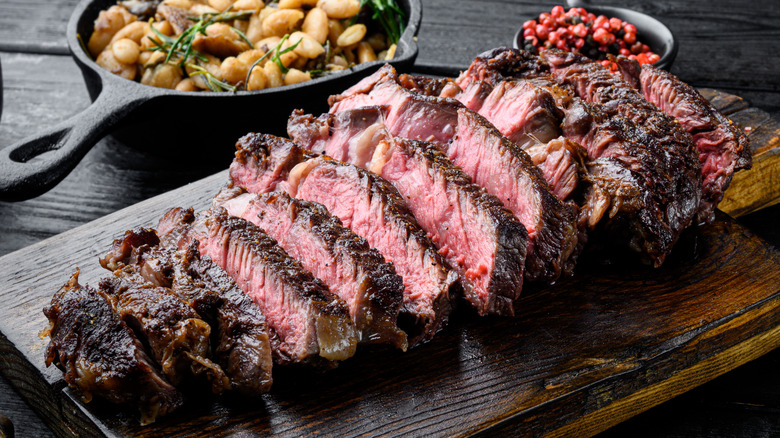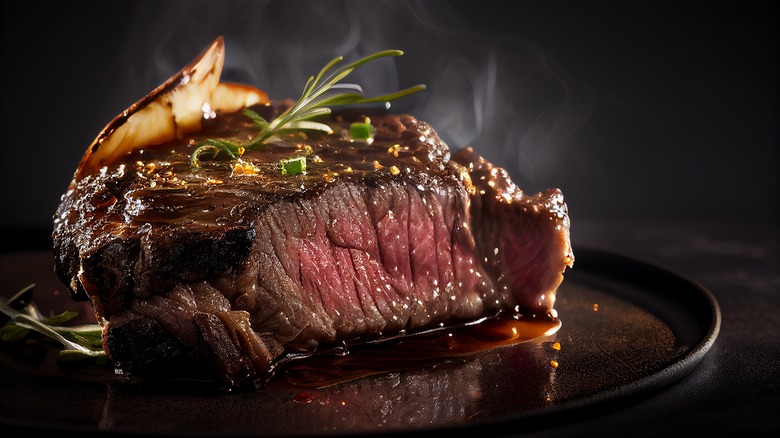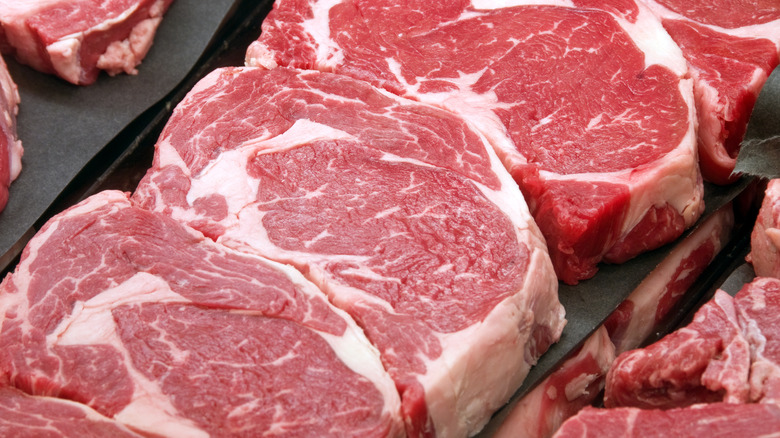How To Cook A Ribeye Steak In A Pan Like A Pro
Cooking a ribeye in a pan can seem like an intimidating task. Like filet mignon or prime rib, it's an expensive steak cut, so you want to hit it out of the park. Getting a perfectly cooked ribeye is all about heat management and temperature.
Cooking ribeye in a pan is one of the easiest ways to impart great flavor. When you cook steak in a pan, you get the benefit of developing a nice, brown crust, courtesy of the Maillard reaction. To get a good crust, salt and rest the steak for at least 40 minutes before cooking, preferably uncovered in the refrigerator overnight. Let it come to room temperature for about an hour before cooking. And be sure to pat it dry with a paper towel and sprinkle it with salt.
You can use a stainless steel pan or a cast-iron skillet — anything that takes heat well. Using a neutral oil in the pan will ensure a good sear. Use about two tablespoons (and save the butter for later). Place the steak in the hot pan and cook, flipping as frequently as you want. Sear the edges and render the fat cap, then add a dollop of butter, perhaps throwing some sprigs of rosemary or thyme and a smashed clove of garlic or shallot for extra zhuzh. Baste the steak a few times, then remove it from the heat and rest it for at least five minutes before digging in.
Try a reverse sear for better control
A reverse-seared steak is a great way to make sure the interior of the steak is done to your liking — no guesswork, no poking and prodding while hovering over a hot, spattering pan. A reverse sear involves gently bringing the ribeye's interior up to temp in the oven until it's about 15 degrees Fahrenheit shy of your ideal doneness. When you sear the ribeye in the hot pan, that internal temperature will rise, and you'll get a nice, golden-brown crust. A reverse sear is also a great candidate for compound butter to add some extra flavor.
To reverse-sear successfully, you'll need an oven-safe, instant-read probe thermometer so you can monitor the ribeye's temperature gains. The pan can heat up while the ribeye roasts — make it as hot as it will get. When the steak reads 115 degrees Fahrenheit, pull it from the oven and sear it in the hot pan as you would normally, but only for as long as it takes to form a crust — about 45 seconds — and pull it off a few degrees shy of being done. The carryover cooking will cook the ribeye the rest of the way.
Why cooking ribeye in a pan is the ideal method
Ribeye steaks come from ribs nine through 11 of the cow, where a few different muscles come together. It's a highly sought-after cut, known for the marbling throughout, which makes the steak tender, juicy, and flavorful. Due to these veins of fat running through the meat, it's the ideal candidate for a quick, high-heat sear. As the steak cooks, the fat melts and keeps the meat juicy.
It also has the prized ribeye cap steak, the super-flavorful fat and meat cap separated from the "eye" portion of the steak. Cap steak is tender and deeply flavorful because it's nestled near the backbone, where there isn't much movement.
When it comes to bone-in ribeye steaks, they cook slower than boneless steaks, so they're ideal if you're worried about overcooking. If you're going to sear a steak, let it be the ribeye.


